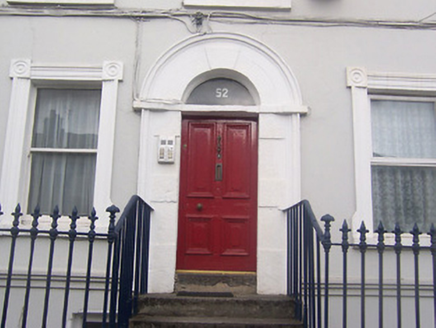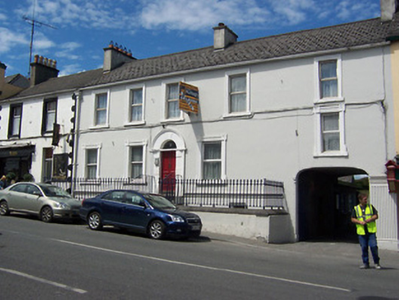Survey Data
Reg No
15310220
Rating
Regional
Categories of Special Interest
Architectural, Artistic
Original Use
House
In Use As
House
Date
1800 - 1830
Coordinates
243351, 252898
Date Recorded
01/07/2004
Date Updated
--/--/--
Description
Terraced five-bay two-storey house over basement house, built c.1815, occupying a sloping site with an integral segmental-headed carriage to the east end of the front façade (south). Pitched slate roof with rendered chimneystacks and cast-iron rainwater goods. Rendered walls with square-headed window openings, irregularly spaced, having shouldered architraves to ground floor openings with coin moulds to corner blocks and with architraved openings over to the first floor openings. Replacement windows throughout. Fluted pilaster adjacent to the carriage arch at the east end of the building. Round-headed doorcase, offset to the west side of centre, having a block-and-start doorcase set in wide architraved frame, moulded lintel, early timber panelled door and with a plain glass overlight. Doorcase reached up flight of steps, flanked to either side iron railings. Low rendered plinth wall having cast-iron railings over (above basement) to the west end of front façade. Road-fronted to the north side of Dominick Street and towards the west end of Mullingar Town centre.
Appraisal
An interesting and substantial private house, which retains its early form, character and a great detail of its early fabric. This house is enlivened by the architraved surrounds to the window openings, the fluted pilaster to the east corner of the main facade, the cast-iron railings and by the unusual and exceptionally wide architraved block-and-start doorcase, which is of a type found in a few of the more refined private buildings in Mullingar (Annebrook House (15310118) for example). This structure effectively negotiates a sloping site and is one of the few private houses fronting on to one of the main central streets in Mullingar that retains its early form. The irregular fenestration pattern is an interesting feature, which could indicate that this building contains the fabric of an earlier building on site. This building is a noteworthy addition to the streetscape of Mullingar and is a worthy addition to the built heritage of the town.



